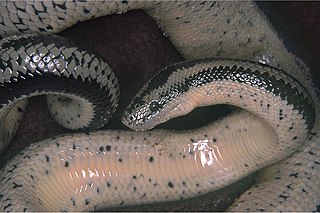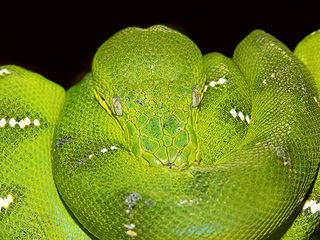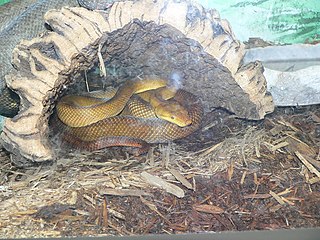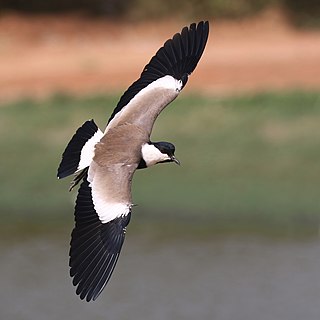
The green tree python is a species of snake in the family Pythonidae. The species is native to New Guinea, some islands in Indonesia, and the Cape York Peninsula in Australia. First described by Hermann Schlegel in 1872, it was known for many years as Chondropython viridis. As its common name suggests, it is a bright green snake that can reach a total length of 2 m (6.6 ft) and a weight of 1.6 kg (3.5 lb), with females slightly larger and heavier than males. Living generally in trees, the green tree python mainly hunts and eats small reptiles and mammals. It is a popular pet, and numbers in the wild have suffered with large-scale smuggling of wild-caught green tree pythons in Indonesia. Despite this, the green tree python is rated as least concern on the IUCN Red List of endangered species.

The desert rosy boa is a species of snake in the family Boidae. The desert rosy boa is native to the American Southwest and Baja California and Sonora in Mexico. The desert rosy boa is one of four species in the boa family native to the continental United States, the other three being the coastal rosy boa and the two species of rubber boas (Charina).

The emerald tree boa is a boa species found in the rainforests of South America. Since 2009 the species Corallus batesii has been distinguished from the emerald tree boa. Like all other boas, it is not venomous.

Corallus hortulana, commonly known as the Amazon tree boa, macabrel, common tree boa, and garden tree boa, is a boa species found in South America. No subspecies are currently recognized. Like all boas it is a non-venomous species.

The rubber boa is a species of snake in the family Boidae and is native to North America. It is sometimes known as the coastal rubber boa or the northern rubber boa and is not to be confused with the southern rubber boa.

Sanzinia madagascariensis, also known as the Malagasy tree boa or Madagascar tree boa, is a boa species endemic to the island of Madagascar. It was once considered conspecific with the Nosy Komba ground boa. Like all other boas, it is non-venomous.

Acrantophis is a genus of terrestrial boid snakes endemic to the island of Madagascar.

Acrantophis madagascariensis is a species of boid snake in the subfamily Sanziniinae that is endemic to the island of Madagascar. Its common names include the Madagascar ground boa and Malagasy ground boa.

The Anjajavy's Protected Area is located on a peninsula of the town of Antonibe, in the district of Analalava and in the north-west region of Madagascar. It is part of the Sofia region of the independent province of Mahajanga and its position is between 47°13’ at 44°22’ of longitude east and 14°58 at 15°07’ of latitude south..

Boa imperator or Boa constrictor imperator is a large, heavy-bodied, nonvenomous species of snake, of the boa genus, that is commonly kept in captivity. Boa imperator is part of the family Boidae and is found in Mexico, Central America and South America west of the Andes Mountains. It is commonly called the common boa,northern boa, Colombian boa and common northern boa and is frequently and erroneously referred to as the red-tailed boa or Colombian red-tailed boa, especially in the pet trade.
Mangerivola Special Reserve is a wildlife reserve in the east of Madagascar. It was established in 1958 and is a hotspot for bird-watchers due to the one hundred species found there, including 63 endemics and many local endemics. There are also seven species of lemur and rare chameleons such as the Lance-nosed chameleon which is registered as endangered on the IUCN Red List of Threatened Species.

Candoia bibroni, commonly known as Bibron's bevel-nosed boa, Bibron's keel-scaled boa, the Pacific tree boa, or the Fiji boa, is a boa species endemic to Melanesia and Polynesia. Two subspecies are currently recognized, including the nominate subspecies described here. Like all other boas, it is not venomous.

Simalia tracyae, the Halmahera python, is a species of python found only on the Indonesian island of Halmahera. It belongs to the family Pythonidae and the genus Simalia. This snake was previously believed to have belonged to the Simalia amesthistina species; however, studies in recent years have caused scientists to distinguish between the two types of snakes, resulting in the reclassification of the Halmahera python as its own species.

A spur is an outgrowth of bone covered in a sheath of horn found in various anatomical locations in some animals. Unlike claws or nails, which grow from the tip of the toes, spurs form from other parts of the foot, usually in connection with joints where the toes meet the foot or the foot meets the long bones. Spurs are most commonly found on the hindfeet, though some birds possess spurs at the leading edge of the wings.

The Sanziniinae are a subfamily of boid snakes containing four species endemic to the island of Madagascar.

Madagascar Exotic is a small privately run reserve at Marozevo, on National Road N2, 75 km (47 mi) east of Antananarivo, between the towns of Manjakandriana and Moramanga. It is a popular tourist stop between Antananarivo and Madagascar's Andasibe-Mantadia National Park.

The Booidea, also known as booid snakes, are a superfamily of snakes that contains boas and other closely related boa-like snakes. As of 2017, Booidea contains 61 species, including the eponymous neotropical Boa constrictor, anacondas, and smaller tree and rainbow boas as well as several genera of booid snakes from various locations around the world: Candoia from New Guinea and Melanesia, sand boas (Eryx) from Northeast Africa, the Middle East, and Southwest Asia, Charina and Lichanura from North America, Ungaliophis and Exiliboa from Central America, Acrantophis and Sanzinia from Madagascar, and Calabaria from tropical west-central Africa.

The Nosy Komba ground boa is a boa species endemic to the island of Madagascar. It is brownish in colour and is found on the western side of the island. It was once considered conspecific with the Madagascar tree boa. Like all other boas, it is not venomous.
Chilabothrus schwartzi, also known as the Crooked-Acklins boa or Crooked Aklins boa, is a species of snake. It is endemic to the southern Bahamas, specifically to Crooked Island and Acklins. It was originally described as a subspecies of Epicrates chrysogaster, but it was elevated to full species status in 2018. In fact, molecular data suggest a closer relationship with Chilabothrus argentum than with Chilabothrus chrysogaster.
















